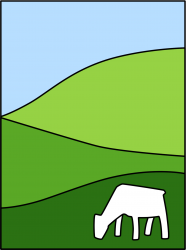DAIRY LIVESTOCK – SUPPLY AND DEMAND
By David Russell, Autumn 2008
At a time when all prices, costs and values associated in any way with the dairy industry have gone into orbit, it is interesting to speculate on what price levels quality in-calf cows and in-calf heifers will command in the autumn of 2009 and again in the autumn of 2010.
The $2,000 plus price tag that is currently being paid is simply a factor of supply and demand. The high dairy payout has created a huge confidence boost which translates through to many more conversions and a big demand for additional dairy cows and in-calf heifers.
Short Supply
There is no immediate source of supply for those extra animals, so the price has risen dramatically. Simple supply and demand economics.
Very often these price spikes are relatively short lived. The high prices create a profit making opportunity for a number of people who grab the chance, and move quickly to supply stock to meet the demand. And, lets face it, we can “manufacture” more dairy cows in just two years, so it is possible to meet the demand in a relatively short period of time.
Overview
But we need to go back one step further to see whether the new level of demand is going to be short lived, or whether it will stretch on for a number of years. There is an argument that the demand for extra dairy cows will continue for a long period. This argument looks at the ever expanding world wide demand for food, coupled with the ongoing world oil crisis. The high price of oil (another supply and demand situation) is leading us towards bio fuels – oil manufactured from plants. Most of the plants that yield oil are a major component of our food chain – either as stock food, or used directly for human consumption.
If the world starts meeting its energy needs by diverting part of the food into oil we put real pressure on the food supply. In fact, we are told that the world is currently consuming more food than it is producing and reserve stocks of food are rapidly depleting.
Food producing countries (and New Zealand is a good example) have a unique opportunity to capitalise on the world food shortage and one very good way of doing that is to expand our dairy production.
That means more conversions which in turn means an ongoing demand for more dairy cows.
So we are back to the supply and demand equation. High demand and static supply forces prices up; high prices encourage an increase in supply; prices will remain high, even with increased supply provided the demand continues or increases; but if the level of demand falls off we have an oversupply and the prices crash.
All of those issues are swirling round us at the present time leaving farmers and their advisors with some major commercial decisions.
Timing?
First, the commercial decisions. Are dairy cows really worth $2,500 or is this simply a supply and demand price spike that will level itself out by the autumn of 2009, – or 2010? On the supply side, we know that we can “manufacture” many more heifers to calve down for the 2009-2010 dairy season.
New Zealand has around 3,800,000 dairy cows. They produce around 1,700,000 viable female offspring each year. We need about 900,000 for herd replacements. That leaves us with a resource base of 800,000 that could be used to expand the national dairy herd. Obviously, about half of that 800,000 would not be good enough quality to seriously consider as part of our ongoing national herd, but there must be many more than we currently retain, that could be used.
I have seen some figures that suggest that we increased that number of dairy heifers reared in the spring of 2007 by 26%. That’s an extra 230,000 heifers that will go a long way to meeting the extra demand for the start of the 2009-10 dairy season.
If there is no further expansion of demand at that time, the price spike will be over and cow prices will level out to say $1,500 in the autumn of 2009 and probably come back to a more “normal” level of (say) $1,200 in 2010.
If you follow all of that logic it is easy to understand why many 50/50 sharemilkers are selling their herds for $2,500/head this season. They may have gone forever, or they could be just taking a year or two out and may rejoin the industry in a couple of years when they can buy a new herd for $1,200-1,500/head.
On the other side, it is hard to understand why some prospective 50/50 farmers are buying their first herd, when cows cost $2,500. Surely, it would be better to stick to lower order for another year or two?
These are difficult decisions. It is easy enough to understand the logic that drives price rises and price falls, but it is seriously difficult judging the timing of the factors that drive price changes.
Taxation
There are also some taxation issues to be dealt with.
Many farmers who are using the Herd Scheme method of valuing their livestock for taxation purposes will have assumed that the values will peak in the 2007-08 income year, and will have fallen to lower levels when 2008-09 Herd Scheme values are determined (autumn 2009). Based on that they will by now have filed elections with Inland Revenue to exit the Herd Scheme for the 2009 income year.
The correct timing of these arrangements will have major tax saving consequences. To achieve maximum tax benefit you need to exit the Herd Scheme when values peak and then look to re-enter the Scheme when values hit a trough.
Your accountant will be on to that issue.
